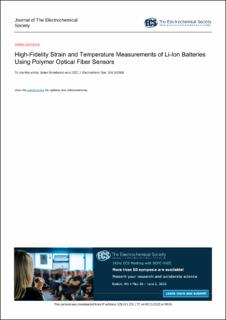| dc.contributor.author | Bonefacino, Julien | |
| dc.contributor.author | Ghashghaie, Sasan | |
| dc.contributor.author | Zheng, Tianye | |
| dc.contributor.author | Lin, Chun-Pang | |
| dc.contributor.author | Zheng, Wenwei | |
| dc.contributor.author | Albero Blanquer, Laura | |
| dc.contributor.author | Huang, Jiaqiang | |
| dc.contributor.author | Gervillie, Charlotte | |
| dc.contributor.author | Tam, Hwa-Yaw | |
| dc.contributor.author | Tarascon, Jean-Marie | |
| dc.contributor.author | Boles, Steven | |
| dc.date.accessioned | 2023-02-02T09:41:13Z | |
| dc.date.available | 2023-02-02T09:41:13Z | |
| dc.date.created | 2022-09-28T09:33:36Z | |
| dc.date.issued | 2022 | |
| dc.identifier.citation | Journal of the Electrochemical Society. 2022, 169 (10), . | en_US |
| dc.identifier.issn | 0013-4651 | |
| dc.identifier.uri | https://hdl.handle.net/11250/3047931 | |
| dc.description.abstract | The convergence of fiber optic sensing with lithium-ion batteries holds great promise for observing key cell parameters in real time, which is essential to every level of decision making, from design and engineering to finance and management. Optical sensors based on fiber Bragg gratings have recently been demonstrated as an ideal tool for measuring these metrics with sufficient temporal and spatial resolution. In this work, we extend the use of fiber Bragg gratings to polymeric optical fibers which have notably greater thermal and strain coefficients than their common silica counterparts. We demonstrate that a polymer optical fiber sensor paired with a silica-based sensor, both affixed to the external package of a lithium battery, can concurrently generate high fidelity temperature and volumetric expansion data through this non-invasive approach. The quality of this data allows for further assessments as mechanical characteristics associated with dimensional changes of cells may indicate more than simple charging or discharging during cycling. While internal monitoring remains essential for future diagnostics, external monitoring using polymer fiber sensors offers a straightforward, superficial, and cost-effective sensing solution that opens a new avenue for real-time cell assessment, prognostics, and packaging considerations. | en_US |
| dc.language.iso | eng | en_US |
| dc.publisher | IOP Publishing | en_US |
| dc.rights | Attribution-NonCommercial-NoDerivatives 4.0 Internasjonal | * |
| dc.rights.uri | http://creativecommons.org/licenses/by-nc-nd/4.0/deed.no | * |
| dc.title | High-Fidelity Strain and Temperature Measurements of Li-Ion Batteries Using Polymer Optical Fiber Sensors | en_US |
| dc.title.alternative | High-Fidelity Strain and Temperature Measurements of Li-Ion Batteries Using Polymer Optical Fiber Sensors | en_US |
| dc.type | Peer reviewed | en_US |
| dc.type | Journal article | en_US |
| dc.description.version | publishedVersion | en_US |
| dc.source.pagenumber | 11 | en_US |
| dc.source.volume | 169 | en_US |
| dc.source.journal | Journal of the Electrochemical Society | en_US |
| dc.source.issue | 10 | en_US |
| dc.identifier.doi | 10.1149/1945-7111/ac957e | |
| dc.identifier.cristin | 2056175 | |
| dc.relation.project | Norges teknisk-naturvitenskapelige universitet: 68024013 | en_US |
| cristin.ispublished | true | |
| cristin.fulltext | original | |
| cristin.qualitycode | 2 | |

